This fire roasted eggplant recipe evokes kitchen creativity with a sauce that melds savory, sweet, sour, and garlicky flavors together with a rich and buttery texture. This recipe teaches you how to roast eggplant on a gas stove and create a one-bowl meal in no time! {Vegan}
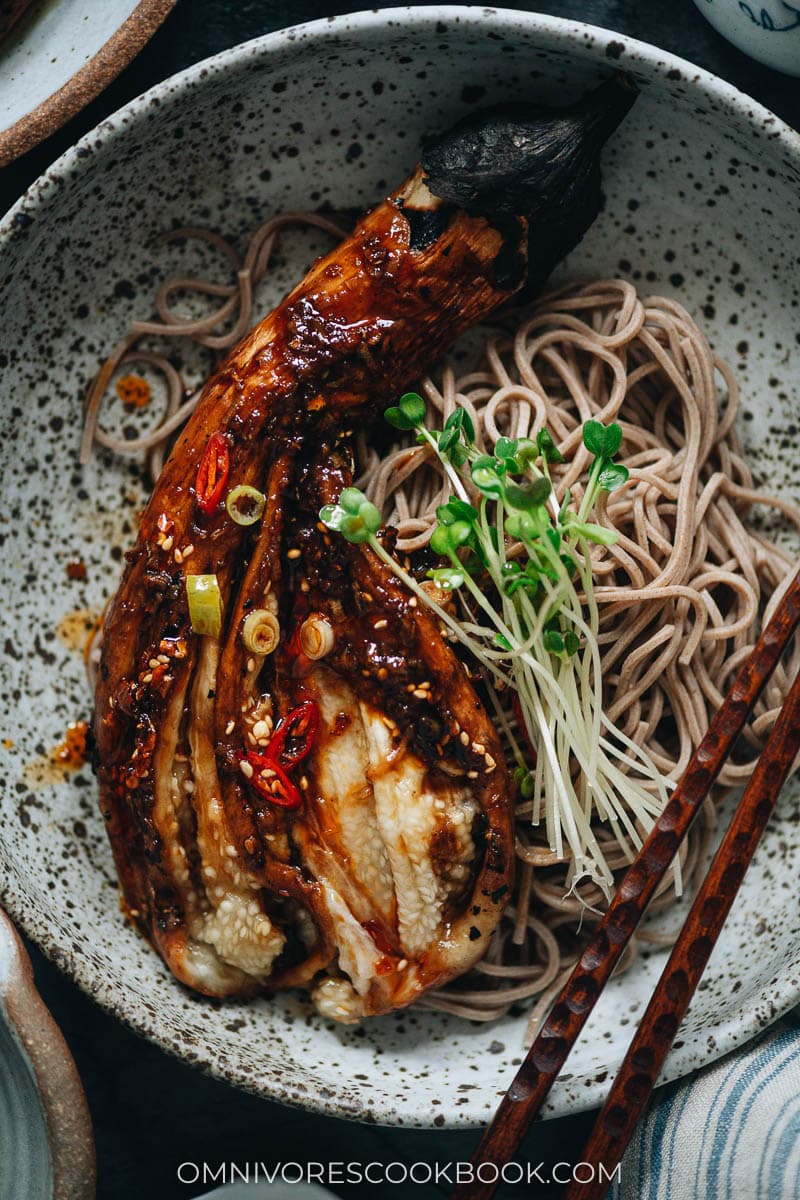
I recently read a fantastic new cookbook called How to Dress an Egg, written by Ned Baldwin and Peter Kaminsky. The book showcases one ingredient and one method of cooking per chapter and then gives you delicious recipes for using that ingredient in your meals. You’ll find things like how to best roast a chicken or make perfect poached cod. I love it because it encourages improvisation and creativity in the kitchen while focusing on those key ingredients.
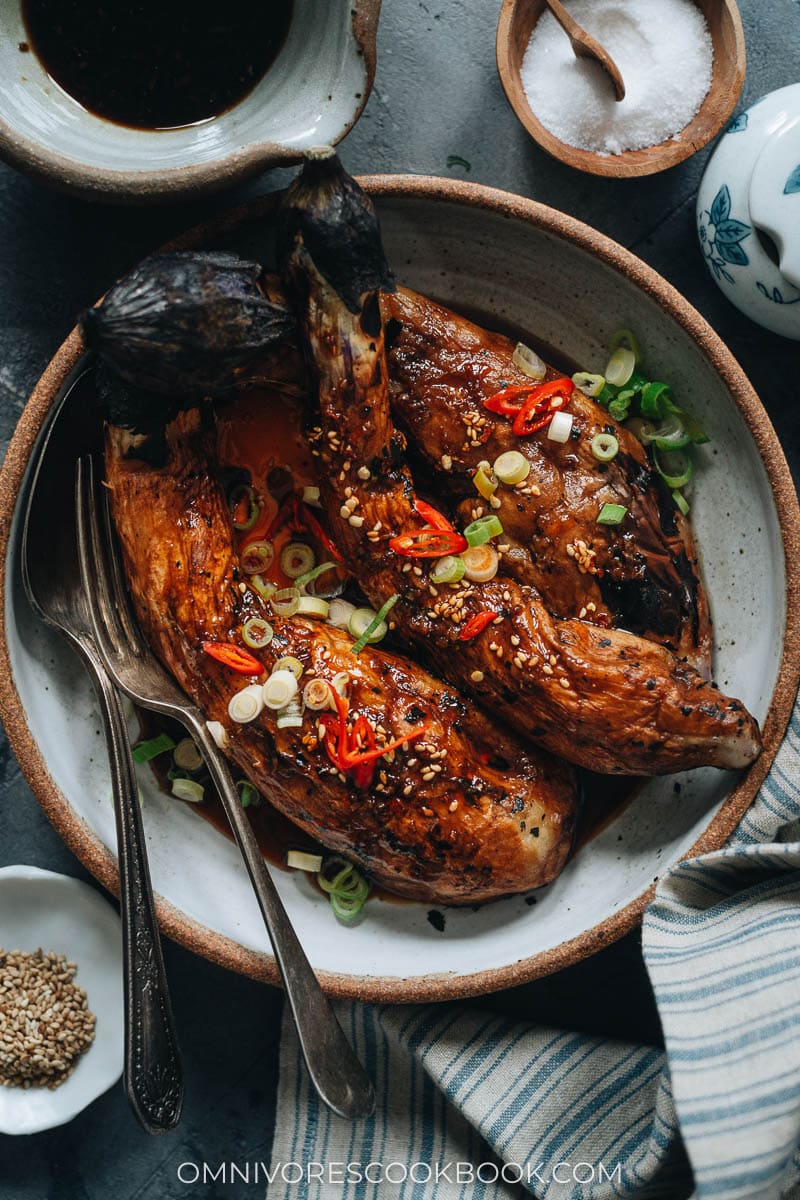
Making smoky eggplant without a grill
Using the book as inspiration, I decided to make fire roasted eggplant. Since I moved to New York from Austin, I’ve been missing the smokiness created by charcoal grilling. Without a grill, I put the eggplant directly on my gas stove and the results were perfect. It takes just six minutes to cook an entire Asian eggplant and there’s no oil needed.
Once done, you simply need to remove the charred skin from the eggplant and it’s ready to serve. The fire roasted eggplant that I made came out with a smoky flavor and a buttery texture inside that wasn’t mushy. You’re going to love it!
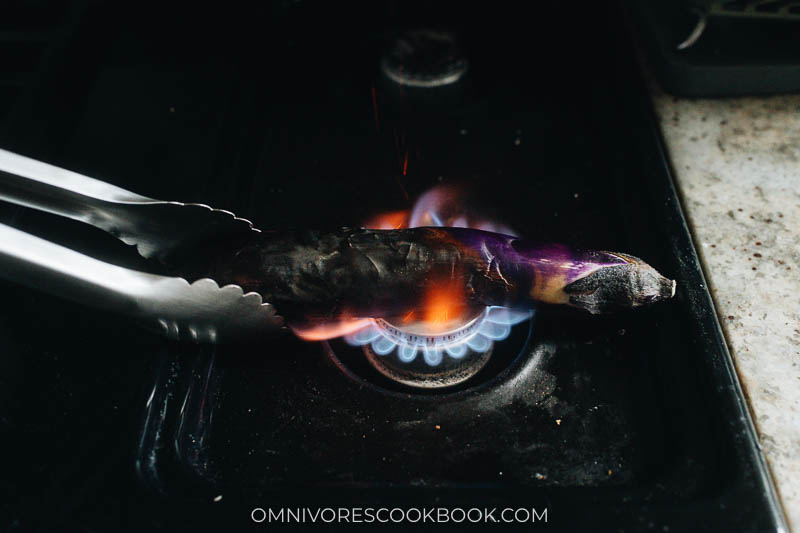
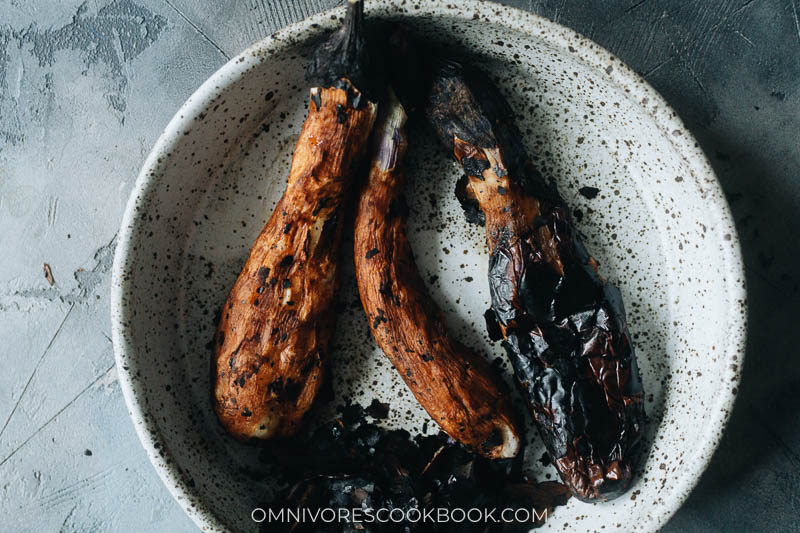
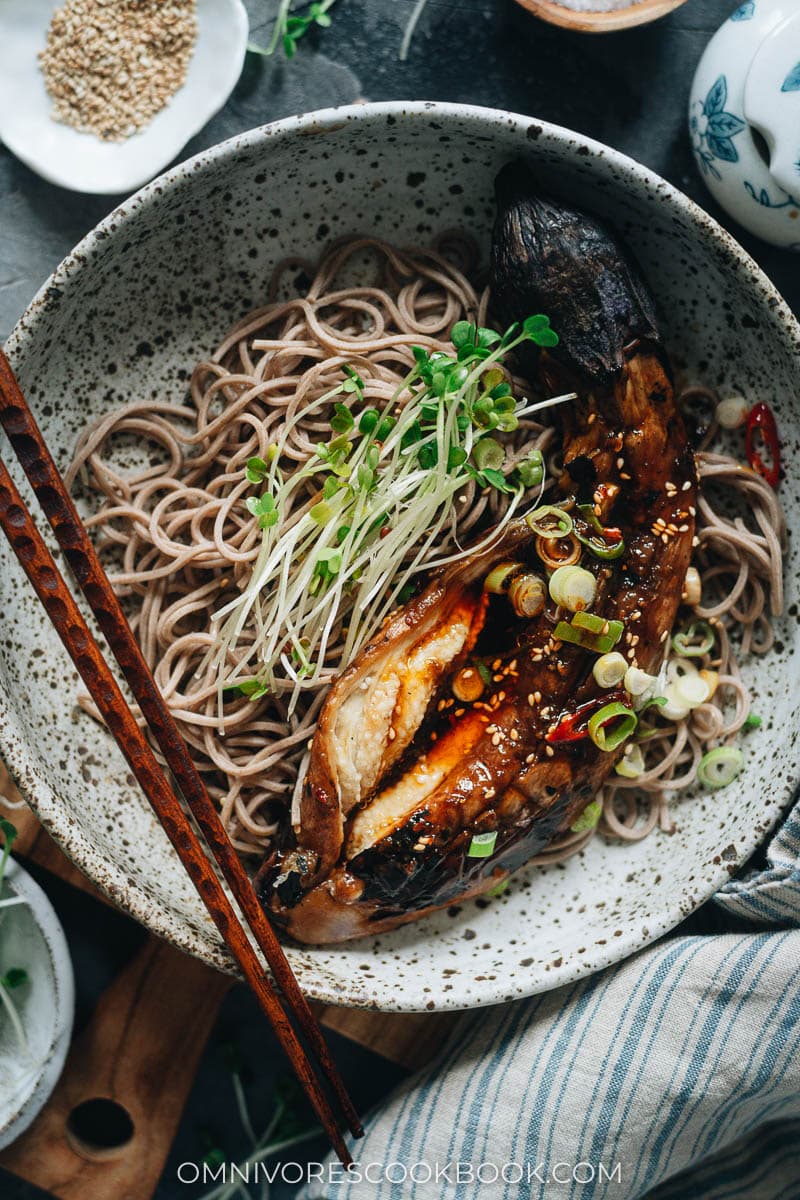
Easy cleanup
If you’re afraid it’s gonna make a mess on the stove, rest assured that it’s very easy to clean up. Eggplant has a quite dry interior, so roasting it won’t cause drippings to leak everywhere. There will be some ashy residue on your stove, but it can be easily wiped clean with a damp paper towel.
How to serve fire roasted eggplant
The cookbook comes with a few delicious-looking recipes on how to use the fire roasted eggplant, but I decided to throw together a dish using my limited pantry ingredients.
I made a simple garlic vinegar sauce to serve with it that is savory, sweet, sour, and fragrant all at once. It really just hits on every flavor craving you might have and unites them harmoniously.
If you wish to make it a meal, I recommend serving it with noodles for a one-bowl dish that’s healthy and delicious. I used soba noodles and served it cold for the warm weather. But you can use your favorite thin noodles and serve it whichever way you like. You can eat this hot or cold. I can’t decide which way I like it best. This fire roasted eggplant is truly one of my new favorite ways to cook with eggplant now!

Other sauce options
You can use the sauces from these recipes to serve with the fire roasted eggplant.
- Spicy Rice Noodle Salad – skip the garlic vinegar sauce in the recipe and use the sauce in my noodle salad recipe to make an easy full meal
- Steamed Eggplant in Nutty Sauce – Upgrade the steamed eggplant with this recipe and serve it with sesame sauce!
- Homemade Hoisin Sauce
- Chinese BBQ Sauce
- You can use the eggplant to make Baba Ganoush
Serve the eggplant with these recipes
You can also serve the fired roasted eggplant with these recipes to make a full meal.
- Chicken Fried Rice
- Vegetable Lo Mein
- 15-Minute Korean Noodle Soup
- Instant Pot Lentil Soup (Chinese Style)
- 15-Minute Garlic Noodles

Want to learn more about Chinese Cooking? Sign up my newsletter to receive the 5-Day Chinese Cooking Crash Course and recipe update!

Fire Roasted Eggplant with Garlic Vinegar Sauce
Ingredients
- 1 lb (450 g) Chinese long eggplant (or 2 to 3 small eggplants)
Sauce (*Footnote 1)
- 2 tablespoons Chinkiang vinegar
- 2 tablespoons maple syrup (or sugar)
- 1 and 1/2 tablespoons light soy sauce (or soy sauce)
- 1 clove garlic , grated
- 1 teaspoon ginger , grated
- Homemade chili oil to taste (Optional)
Serving options
- Boiled soba noodles (or other type of thin noodles)
- Steamed rice
Instructions
- Place the eggplant(s) on a grill over high heat or cook directly on a gas burner turned to medium-high (*Footnote 2). Turn the eggplant from time to time using a pair of tongs, every 30 seconds or so, to char on all sides. When the eggplant is done, the skin will typically have turned darker purple or even black, and it will puff up and then collapse a bit. To test the doneness, gently squeeze it using your tongs to make sure it’s soft throughout. Transfer the cooked eggplant to a large plate and let it cool enough to handle. Gently peel the eggplant and discard the skin. If there’s little flecks of burned skin left here and there, that’s fine.
- Whisk the sauce ingredients together in a small bowl.
- (Optional) If serving with noodles, boil the noodles according to the package instructions. Drain and set aside.
- To serve, pour half of the sauce onto the eggplant and serve it with the rest of the sauce on the side. Place the eggplant onto the noodles (if using) and pour on more sauce if needed. Enjoy warm or at room temperature as a cold dish.
Notes
- Double the amount of sauce if you wish to serve the eggplant with boiled noodles.
- You can roast two eggplants at a time by placing them on opposite sides of the burner.
Nutrition
If you give this recipe a try, let us know! Leave a comment, rate it (once you’ve tried it), and take a picture and tag it @omnivorescookbook on Instagram! I’d love to see what you come up with.













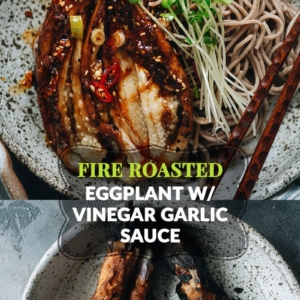
Hello Maggie, I am a new fan of your posts. I’ve been reading a lot of your recipes lately to try Chinese, especially Sichuan cuisine at here in Korea.
I found that you (and other English posts) often use Chinkiang vinegar 鎮江香醋 for many dishes. I do have Chinese black vinegar but it’s not the Chinkiang, and I wonder if I can use the one I have as an alternative for the one you use. What I have is Lao Chen Cu 老陈醋 from Shan Xi 山西 region, and I heard that Chinkiang has a milder aroma and sourness than Lao Chen Cu, but I am not sure. There is so limited amount of information about Chinese vinegar on Korean web, and English posts almost always use Chinkiang, so I couldn’t find the answer. And sadly I don’t speak Chinese well enough to search and read Chinese posts about that matter. Also I’ve never tasted the Chinkiang before. So I am not really sure if I can use my vinegar to try your recipe. Is it okay to use Lao Chen Cu instead of Chinkiang? Have you ever tried it?
Hi I don’t have any idea about the vinigars but in the post “19 essential chinese Ingredients” from Maggie, she describes the Chinkiang vinegar as:
“Chinkiang vinegar, or Zhen Jiang Xiang Cu (镇江香醋), is sometimes called old vinegar (老醋, Lao Cu), or black vinegar (黑醋, Hei Cu). Chinkiang vinegar has a distinctive dark brown color that is almost like that of soy sauce. It has a rich, pungent, and tart flavor, with a fermented, malty taste and woody character that differentiates it from the lighter colored rice vinegar.”
So you might be okay with the Lao Chen Cu 🙂
Hi!
I’m Canadian but I used to live in China. I’m back in. Canada now and I can’t get all the same things as in china. I always use 老醋 for Chinese cooking if I need a dark vinager. It’s always been fine. If you are worried add a little at a time. Regardless of the brand every person had a different sense of taste, so don’t worry about perfect. Make what tastes good to you! It’s interesting you find it salty. I would consider using slightly less soy sauce if you are concerned it will be too salty- that is the other salty flavour in the dish. Good luck!
Gosh I forgot to ask this. If I can use Lao Chen Cu as an alternative for the Chinkiang, how should I adjust the amount of the vinegar? I guess their aroma, sourness, taste? (sounds weird but I guess my Lao Chen Cu is a bit salty) … would differ a lot (although I’ve never Chinkiang before), so I am not so sure how much I should use the Lao Chen Cu. Do you have any suggestion?
(Sorry for messing with two comments. I couldn’t find the button to revise my prior comment. Also, if there is something awkward or rude in the question, please forgive them, I’m a Korean national and my English is clumsy.)
My new favorite blog even though I am vegan! I canèt wait to develop some new sauces. I used to live in Taiwan so I am familiar with these ingredients!
I’m so glad you find my recipes helpful 🙂 I started to cook more vegan dishes since my husband switched to plant-based. I definitely plan to post more vegan recipes in the future!
I did love this recipe. I grow my own Asian eggplant and have a bumper crop. I must admit I made a bit of a modification, I used some vinegar and some tamarind sauce and since we don’t use much sugar, I used some sugar free maple syrup and stevia. I also had roasted garlic and used that. Used green onions and thai basil as garnish (I grow them, too.) Both my wife and I found this yummy and since I used the grill the only pot was for the soba noodles….easy clean up! I have made several of your recipes and have found all delicious. Thank you so much for this site.